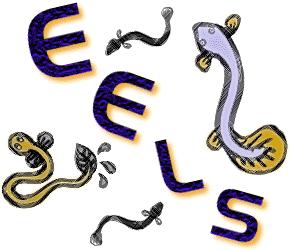|

Eels have been eaten in Japan since the Jomon period (8000 B.C. - 200
B.C.), but they only first appeared in literature in the Manyoshu (Japan's oldest anthology of poems). In
one of the 31-syllable tankas in this collection, eels are mentioned as being good for maintaining one's
health.
The volume of eel consumption in Japan is presently at about 70,000 tons per year. Almost all of the eels consumed
are commercially bred, with wild eels constituting only a small percentage of the total. Wild eels are mostly from
Kumamoto and Kochi prefectures while commercially produced eels come mainly from Aichi, Gifu
and Shizuoka prefectures. In addition, live eels imported from Taiwan, China, and the United States account
for 30 percent of the cultivated eels consumed in Japan.
Large eels can be up to 1.3 meters long, but those sold in market are usually around 60 centimeters. Cultivated
eels usually contain larger amounts of fat and do not have a muddy smell or peculiarly strong taste.
|

![]()

![]()